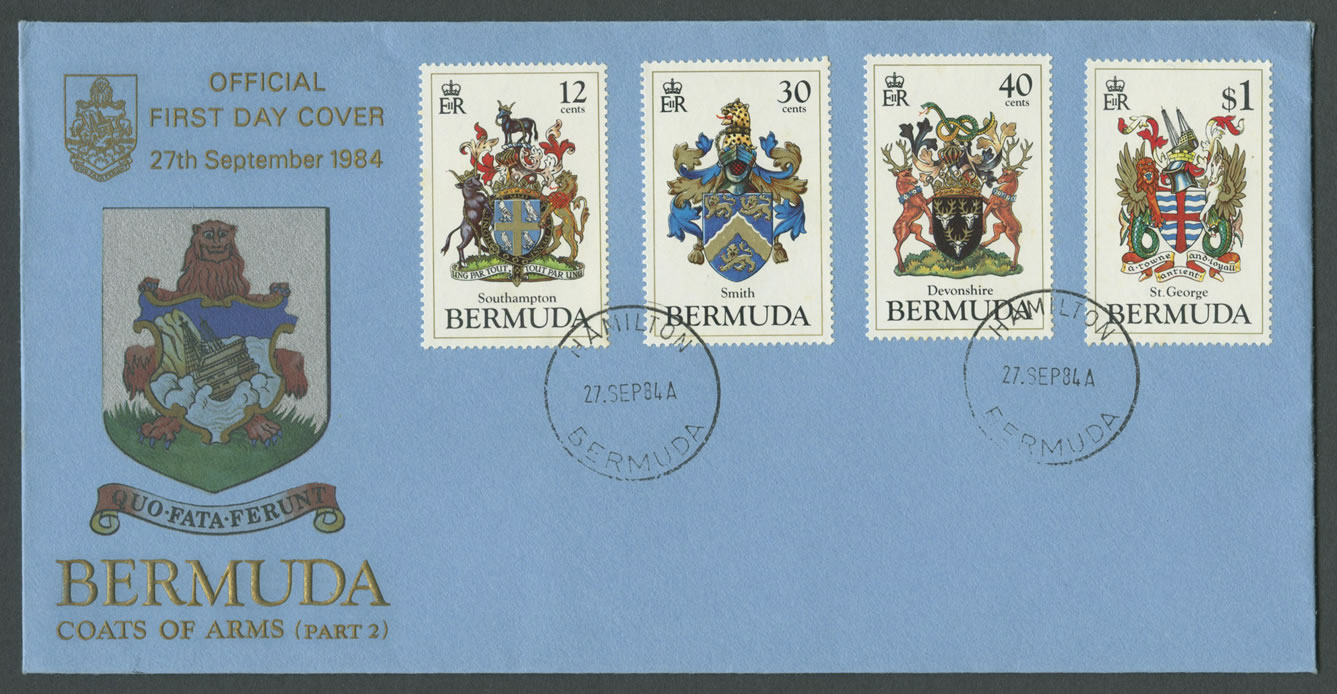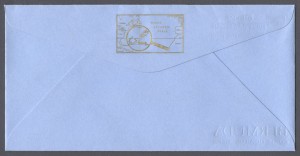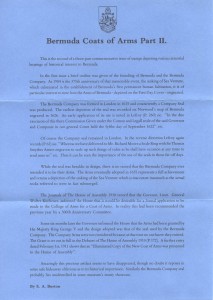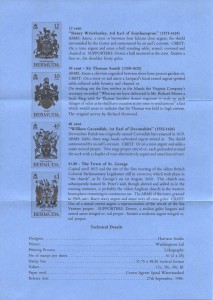Your basket is currently empty!

1984 Bermuda Coats of Arms Part 2
Further heraldic commemorative issues
Date: 27th September 1984
Stamps: 12c Henry Wriothesley, 3rd Earl of Southampton (1573-1624); 30c Sir Thomas Smith (1558-1625); 40c William Cavendish, 1st Earl of Devonshire (1552-1626) and $1 The Town of St. George.
Type: Official First Day Cover
CDS: 27.SEP84A HAMILTON BERMUDA
Cachet: OFFICIAL FIRST DAY COVER 27th September 1984 BERMUDA COATS OF ARMS (PART 2). Bermuda map and magnifying glass (reverse)
Bermuda Coats of Arms Part II
This is the second of a three-part commemorative issue of stamps depicting various armorial bearings of historical interest to Bermuda.
In the first issue a brief outline was given of the founding of Bermuda and the Bermuda Company. As 1984 is the 375th anniversary of that memorable event, the sinking of Sea Venture, which culminated in the establishment of Bermuda’s first permanent human habitation, it is of particular interest to note how the Arms of Bermuda – depicted on the First Day Cover – originated.
The Bermuda Company was formed in London in 1615 and concurrently a Company Seal was produced. The earliest depiction of the seal was recorded on Norwood’s map of Bermuda engraved in 1626. An early application of its use is noted in Lefroy (P. 260) sic. “In the due execucon of this there Commission Given under the Comon and Legall seale of the said Governor and Companie in our general Court held the fyfthe day of September 1622” etc.
Of course the Company seal remained in London. In the reverse direction Lefroy again records (P.62) sie. “Wherea we have delivered to Mr. Richard Moore a Seale Ring with Sir Thomas Smythes Armes engraven to seale up such things of value as he shall have occasion at any tyme to send unto us” etc. Thus it can be seen the importance of the use of the seals in those far off days.
While the seal was heraldic in design, there is no record that the Bermuda Company ever intended it to be their Arms. The Arms eventually adopted in 1635 represents a full achievement and retains a depiction of the sinking ofthe Sea Venture which is inaccurate inasmuch as the actual rocks referred to were in fact submerged.
The Journals of The House of Assembly 1910 record that the Govenor, Lieut. General Walter Kitchener, informed the House that it would be desirable for a formal application to be made to the College of Arms for a Coat of Arms. In reality this had been recommended the previous year by a 300th Anniversary Committee.
Some six months later the Governor informed the House that the Arms had been granted by His Majesty King George V and the design adopted was that of the seal used by the Bermuda Company. The Company Arms were not concidered because at that time no one knew they existed.
The Grant is set out in full in the Debates of The House of Assembly 1910 (P.172). A further entry dated February 1st, 1911 shows that an “Illuminated Copy of the New Coat of Arms was presented to the House of Assembly”.
Amazingly this precious artifact seems to have disappeared, though no doubt it reposes in some safe hideaway oblivious as to its historical importance. Similarly the Bermuda Company seal probably lies unidentified in some museum’s musty showcase.
By E. A. Burton
12 cent – “Henry Wriothesley, 3rd Earl of Southampton” (1573-1624)
ARMS: Azure, a cross or between four falcons close argent; the shield surrounded by the Garter and surmounted by an earl’s coronet.
CREST: On a torse argent and azure a bull standing sable, armed, crowned and chained or.
SUPPORTERS: Dexter a bull tinctured as the crest. Sinister a lion or, the shoulder fretty gules.
30 cent – Sir Thomas Smith (1558-1625)
ARMS: Azure a chevron engrailed between three lions passant gardant or,
CREST: On a torse or and azure a Leopard’s head erased argent spotted sable, collared sable bezanty and chained or.
On sending out the first settlers to the Islands the Virginia Company’s secretary recorded “Whereas we have delivered to Mr. Richard Moore a Seale Ring with Sir Thomas Smythes Armes engraven to seale up such thinges of value as he shall have occasion at any time to send unto us” a fact which would seem to indicate that Sir Thomas was held in high esteem.
The original survey by Richard Norwood.
40 cent – “William Cavendish, 1st Earl of Devonshire” (1552-1626)
Devonshire Parish was originally named Cavendish but renamed in 1619.
ARMS: Sable, three stags heads carboshed argent attired or. The shield surmounted by an earl’s coronet.
CREST: Or on a torse argent and sable a snake nowed proper. Two stags proper attired or, each garlanded around the neck with a chaplet of roses alternatively argent and azure leaved vert.
$1.00 – The Town of St. George
Capital until 1815 and the site of the first meeting of the oldest British Colonial Parliamentary Legislature still in existence, which took place in “the church” at St. George’s on 1st August, 1620. This church was subsequently named St. Peter’s and, though altered and added to in the ensuing centuries, is probably the oldest Anglican church in the western hemisphere remaining in continuous use.
The ARMS of the town, granted in 1969, are:- Barry wavy argent and azure over all cross gules.
CREST: Out of a mural crown argent a representation of the wreck of the Sea Venture proper.
SUPPORTERS: Dexter, a sealion gules langues and armed azure winged or, tail proper. Sinister a seahorse argent winged or, tail proper.
Technical Details
Designer: Harrison Studio
Printer: Waddingtons Ltd
Printing Process: Lithography
No of stamps per sheet: 50 (2 x 25)
Stamp Size: 31.75 x 48.26 vertical format
Values: 12c, 30c, 40c, $1
Paper used: Crown Agents Spiral Watermarked
Release date: 27th September, 1984.



Leave a Reply
You must be logged in to post a comment.